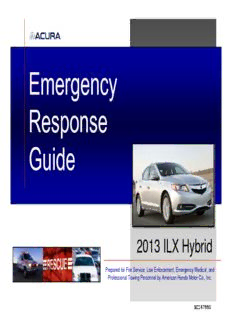Table Of ContentEmergency
Response
Guide
2013 ILX Hybrid
Prepared for Fire Service, Law Enforcement, Emergency Medical, and
Professional Towing Personnel by American Honda Motor Co., Inc.
Introduction
This information has been prepared to help emergency response professionals
identify an Acura ILX gasoline-electric hybrid and safely respond to incidents
involving this vehicle.
We hope this publication provides the kind of information you need. As with
other Honda Emergency Response Guides, it is available for reference or
downloading at https://techinfo.honda.com
If you have any questions or wish to order printed copies please contact your
local Acura dealer or Acura Client Relations at (800) 382-2238.
Acura wants to thank you for your concern and efforts in protecting Acura
customers and the general public.
Contents
• Introduction
• Vehicle Description • Emergency Procedures
- Identifying an Acura ILX Hybrid - Vehicle Fire
- Key Components - Submerged or Partially Submerged
- Gasoline Engine Vehicle
- Electric Motor - Preventing Current Flow Through High-
- 12-Volt Battery Voltage Cables
- Underhood Fuse Box - Best Method for Preventing High-
- High-Voltage Battery Module Voltage Current Flow
- High-Voltage Battery Box - Second-Best Method for Preventing
- High-Voltage Cables High-Voltage Current Flow
- Extricating Occupants
• Potential Hazards - Cut Zone
- Flammable Fluids - Moving or Towing a Acura ILX Hybrid
- Undeployed Airbags and Tensioners
- Electric Shock Potential
- High-Voltage Battery Electrolyte
- 12-Volt Battery Electrolyte
Vehicle Description
IDENTIFYING AN ACURA ILX HYBRID
The easiest way to identify an Acura
ILX Hybrid is by the word “Hybrid” on
the trunk and two front fenders.
Vehicle Description
IDENTIFYING AN ACURA ILX HYBRID
If the word “Hybrid” is not visible on the exterior, the presence of orange
cables under the hood, or orange conduit on the underside of the vehicle
also identify it as a hybrid.
Orange cables under the hood, or orange
shielding fastened to the underside of the
vehicle also tell you it is a hybrid.
Vehicle Description
KEY COMPONENTS
Gasoline Engine High‐Voltage
&Transmission Cables
AC Compressor
Motor High‐Voltage
Battery Box
12V Battery
Underhood
Fuse Box
Fuel Tank
Fuel Lines
Underhood
Fuse Box
12V High‐Voltage
Battery Battery Box
High‐Voltage Fuel Tank
Motor
Cables
Vehicle Description
GASOLINE ENGINE
The main power source of an Acura
ILX Hybrid is a conventional
gasoline engine, located under the
hood.
ELECTRIC MOTOR
During start-up and acceleration, an electric motor, located between the
engine and the transmission, provides assistance to the engine. During
braking and deceleration, the motor acts as a generator, recharging both the
high-voltage battery module and the 12-volt battery.
Vehicle Description
12‐VOLT BATTERY
A conventional 12-volt battery located under the hood powers all standard
electronics. It also provides power to the high-voltage battery control
systems. Disconnecting or cutting the negative cable to the 12-volt battery
may be necessary in an emergency situation.
UNDERHOOD FUSE BOX
The Acura ILX Hybrid has a fuse box under the hood on the left side of the
engine compartment. Removing the main fuse from the fuse box may be
required in an emergency situation.
Underhood
Fuse Box
12‐Volt
Battery
Vehicle Description
HIGH‐VOLTAGE BATTERY MODULE
The electric motor in the Acura ILX
Hybrid is powered by a lithium ion (Li-
Ion) battery module. This battery
module contains four groups, or
“stacks,” of ten 3.6-volt cells. Each
cell is slightly larger than some cellular
phones. The total voltage is 144 volts.
One of Four
Battery
Since the battery module is recharged
”Stacks”
by the electric motor whenever the
vehicle decelerates, the battery does
not need external charging.
Vehicle Description
IPU case
HIGH‐VOLTAGE BATTERY BOX
The high-voltage battery module is
surrounded by a sturdy metal
framework, such as that shown here
with the cover removed. The battery
is packaged with other important
components which, together, make
up the Intelligent Power Unit (IPU).
All high-voltage circuits inside the Other High‐
High‐Voltage
Voltage
IPU are completely insulated and
Battery Module
Components
isolated from the vehicle body.
For maximum safety, the high-
voltage battery box is positioned
behind the seat-backs where it is
well-protected from potential
damage in a collision.
Description:NFPA's Alternative Fuel Vehicles (AFV) Safety Training Program provides tools and information that Electric/hybrid vehicle technology has changed!

